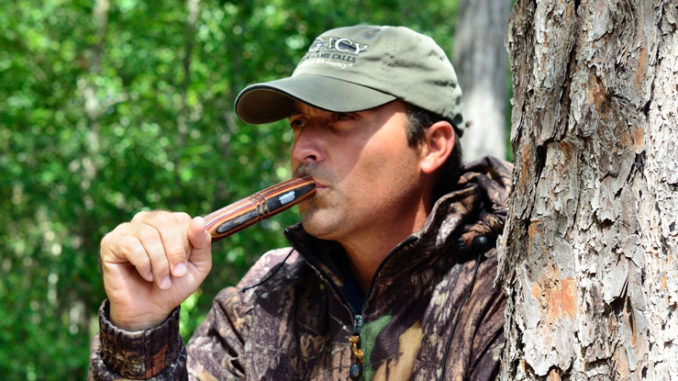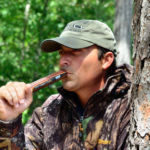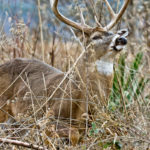
Calling, rattling, setting up closer to bedding areas may put that buck in your sights.
For three years, I hunted this same buck with only fleeting sightings of him — usually in the opening week and during the rut. Not once did I ever have even a remote opportunity to draw my bow. I knew something would have to change or he would die of old age or at the hands of a hunter on an adjacent property.
I had plenty of trail-cam photos and knew where he was at different times of the season — at least at night. Hunting food and travel corridors had failed miserably. I knew if I was going to have a chance I had to push the envelope and get more aggressive. It was an all or nothing gamble.
It began one January when I hung stands right as close as I could to his bedding area, knowing that when the time was right, I could take one of those stands and give myself the best chance to take this deer.
According to the 2012 deer report published by the S.C. Department of Natural Resources, breeding activity for whitetail deer in South Carolina peaks around Oct. 30. There is a significant decline in activity after this date, but for hunters wanting to bag a trophy after the peak of the rut, being aggressive will often put a buck in your lap.
Chad Simpson of Hendersonville, N.C., prefers to hunt bigger bucks during the post rut.
“In the first week of November, I feel more confident I can catch a mature buck less aware and more vulnerable,” he said. “During this time, I will grunt aggressively, rattle and use a lot of challenging techniques, including snort-wheeze, to get a buck to commit.”
But Simpson is also quick to point out that you have to start well before November to be in the right place to take a nice buck.
When the peak of breeding activity begins to taper off, a few remain unbred, and bucks are searching for them, often traveling great distances in their search. To put yourself in an area where you can get a shot begins with getting there undetected.
“When I hang my stands in late winter, I go to a lot of effort to plan my access to these stands.” Simpson said. “Perhaps the No. 1 consideration when choosing a good stand location is access. If you cannot get to your stand without alerting every deer in the country of your presence, your sit is just a waste of time.”
Planning access and exit routes is paramount to a good setup. Admittedly, Simpson may go to the extreme, using a backpack blower and rake to remove every element of debris from the trail he uses to reach stand, but it makes access totally silent. Even a month or two after cleaning, he knows that 90 percent of the debris will be gone and he will be walking to his stand on bare dirt.
Second is a total scent control. Getting the perfect wind is largely luck; hunting on a marginal wind, you are well-served to spend time getting yourself and gear as scent-free as possible. This means showering in scent-free soap, using scent-free deodorant and taking advantage of the technology available with scent-free clothing, sprays and other scent eliminators. Choose one brand and use it exclusively. Cover everything completely, including your gun or bow. If your body and clothing is scent free, but your bow or gun reeks of WD-40 or Hoppes No. 9, your hunt is over before it begins. Scent-free lubricants and even dry lubricants are available to keep it weapons clean and scent free. Lastly, wear rubber boots, even hip boots if you feel you may be brushing up against tall grass or straw. Hunters have different levels of success using attractant scents, but cover scents rarely affect deer negatively.
Aggressive tactics include the type of stand you use. When hunting right on top of a trophy buck, a climber or a low-profile, strap-on stand are your best options. Climbers allow you to enter the woods, hunt and leave completely undetected; however, they are bulky and difficult to carry long distances. Strap-on stands can be positioned well in advance, and their low profile helps them be hidden throughout the year. But more than anything, comfort is critical. If you cannot sit still and for long periods of time, the hunt is more than likely not going to produce.
“It always amazes me how many hunters always buy the cheapest stands on the market, knowing they will spend countless hours sitting in them and give no attention to comfort,” Simpson said. “My experience shows that the bigger seat and biggest platform can make or break a good hunt and a good stand.”
Once in your stand, you want to get the buck’s attention. Some hunters like to sit quietly and hope for the best, but bucks late in the rut and post-rut will respond readily to a variety of calls and rattling. Buck grunts, tending grunts and doe bleats all draw in bucks. Knowing how and when to use them can really help. Simpson makes plenty of noise.
“Contrary to many, I like to use the grunt call, and I use it a lot and loud,” said Simpson, who likes calls with adjustable reeds so he can mix doe bleats and buck grunts. “If you have ever heard deer grunt, you know that there are many times they get real aggressive with their vocalization.”
I decided once to ultra-aggressive and began bleating and grunting. I would blow six or seven doe bleats and follow with six or seven buck grunts. I did this continuously for more than 30 minutes, constantly scanning the woods. I finally detected movement to my right, and at 40 yards, there stood what was and still is the heaviest buck I have ever seen — a mature 8-pointer looking for the action he was hearing. A few minutes later he was mine.
While I was still reeling from this nice buck, a 6-pointer came in to check out the action, then another smaller 8-pointer and another and another. In total, seven bucks responded to this aggressive calling. While it doesn’t happen like this often, it does happen.
Another aggressive tactic is rattling. I consistently rattle in more than a dozen bucks every season. Like all things, it doesn’t work all of the time, but it does work. S
“Rattling may not bring them running, but it can and does get their curiosity up,” Simpson said. “While several times I have had bucks appear immediately when rattling, it usually takes a few minutes. If nothing happens, I do it again,and will rattle every 10 minutes or so for the entire hunt.”
Simpson said that by mixing grunts, doe bleats and rattling, mature bucks will respond, believing other bucks are getting the few receptive does in their territory.
How do you rattle? If you have ever heard bucks fighting, you know there is no way to possibly mimic that aggression sitting in a tree banging a set of antlers together. All you are trying to do is to create enough curiosity to get them to investigate.
Many years ago, I decided I wanted to be aggressive and see if I could rattle in a buck on a particular hunt. I climbed a tree along the edge of a 10-year-old cutover, hoping to draw out bucks bedded there. From dawn until 10:30, I rattled and grunted every 10 to 15 minutes. At 10:45, during a rattling session, a buck came charging down the edge of the cutover, stopped at 70 yards, began fighting a tree — and then walked directly under my tree. His antlers are now my primary set of rattling antlers. Too often, hunters will rattle once, nothing charges in and they give up.
“It’s similar to casting a lure for fish,” Simpson said. “We don’t catch a fish on every cast, but we keep casting. Keep calling, keep rattling, and if he’s in the area, he will eventually respond.”
Last, when getting aggressive for post-rut bucks, plan to sit all day, which can be difficult for some hunters. Take a snack, some water and know the old adage “You can’t kill him at camp,” is true.
“My records show that a full 25 percent of the bucks I’ve killed have been taken between 12:30 and 3:00. When the conditions are right, bucks will move all throughout the day, and when waiting for just one encounter, don’t miss it because you are bored.”
Be focused, be ready and be aggressive and you will put your sights on more big bucks as the season moves along.




Be the first to comment